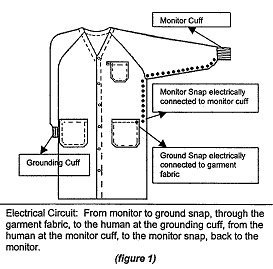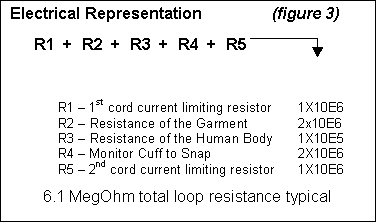X2 Ground Monitor
X2 use with a Ground Monitor
Tech Wear’s patented X2 garment is designed for use with 3M’s 724 Workstation Monitor.
Until the introduction of the X2 garment in 1998, the only method of monitoring charge imbalances on an operator was with a special dual-snap wrist strap that effectively monitored the surface resistivity of the skin on the operator’s wrist. However, the X2’s unique design includes both the wearer and garment in the monitored loop.Here’s how it works: The X2 makes contact with the operator at the two wrist cuffs; one cuff is connected to the fabric of the garment, and the other is insulated from the garment and connected via an isolated conductived path to the monitor snap. The other snap is connected directly to the body of the garment, which is made of conductive OFX-100 or IVX-400 fabric.


This ground snap therefore grounds the entire garment and the operator. The monitor cuff on the wearer’s left and connected monitor snap allow constant resistance monitors to measure the continuity of the garment, human operator and their connection to ground. Taken as a whole, the garment system’s electrical path is monitor-to-cordground-snap, conductive fabric, ground cuff, operator’s body, monitor cuff, isolated path, monitor snap, cord-to-monitor.
To understand what the monitor is seeing, we have to look at the cord, garment, and human operator in terms of their series resistance (see fig 3). There are five resistances to be considered.
Two of them (R1 & R5 in the figure) are 1 Megohm current limiting resistors in standard ground cords. The other three are the resistance of the garment, the resistance of the human operator, and the resistance of the monitor connection to the human operator (R2, R3 and R4 in the figure). In most applications and in most environments, this total loop resistance add up to about 6 Megohms. However, the reality is that this ideal situation rarely exists in most day to day situations for the long term.
There are a couple of innate factors that prevent this ideal situation. For instance, infrequent and/or improper laundering of the garment may increase the resistance in the cuffs and/or in the garment itself. Also, the resistance in the human body varies widely from person to person, the value being dependent on many factors, but most importantly on the condition of their skin. While most peoples resistance measures in the area of 2X104Ω (or 20,000 ohms) to 5X105Ω (500,000 ohms), there are individuals who, because of their dry skin, can measure as high as one or two Megohms. If you add a 2MegΩ person to our loop in the place of R3 in the figure, our total loop resistance goes up to about 9 Megohms, dangerously close to the “fail” point of a 10 Megohm monitor.
Tech Wear Inc.’s X2 dual-path garments are available in a variety of styles, fabrics and colors. These patented garments come with a 100 wash guarantee. That means that the garments will meet the National ESD Association STM 2.1-1997 for static control garments through 100 washes and will remain compatible with your dual monitor set at 35 Megohms.

